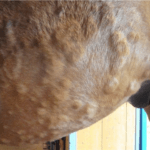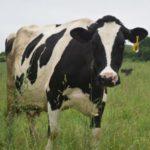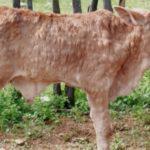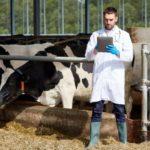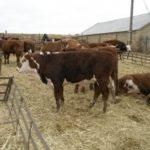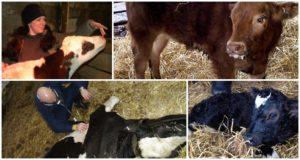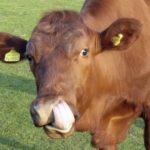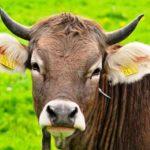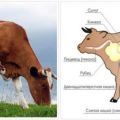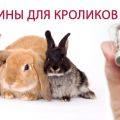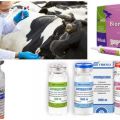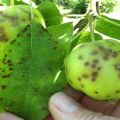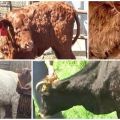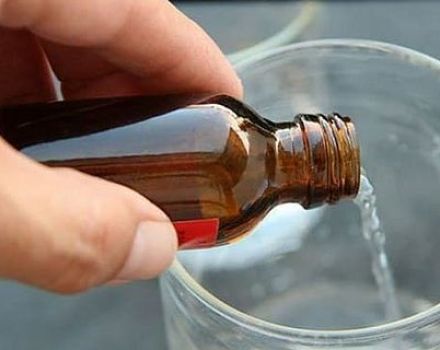Epizootology and symptoms of leptospirosis in cattle, treatment and prevention
Leptospirosis often affects many animals, but cattle most often suffers. The situation requires the immediate intervention of a veterinarian, because the infection spreads at a reactive speed, and the consequences of the disease can become fatal, so you cannot hesitate with therapy. Taking vaccinations seriously and following good hygiene rules will help you avoid trouble.
Characteristics of leptospirosis
Leptospirosis affects many animal species. This infectious natural focal disease affects the internal vessels, gastrointestinal tract, skin and mucous membranes. The disease is accompanied by fever, involuntary abortions or the appearance of sick offspring. The productivity of a sick pet is markedly reduced.
The causative agent of a dangerous disease is microscopic parasites - Leptospira (Genus Leptospira). With multiple magnifications, the pests can be seen to look like thin silvery threads.
Leptospira live in the aquatic environment, so they thrive in lakes, rivers and even sewers, but they quickly die on land. So, in open reservoirs, parasites can live up to 200 days, and in dry soil they do not survive even 12 hours. An outbreak of the disease can occur at any time of the year. Young pets aged 1-1.5 years are harder to tolerate leptospirosis than adult animals. For them, the probability of death reaches 25%.
Epizootology shows that mainly cattle and pigs become victims of the disease. Leptospirosis often affects sheep, goats, dogs, horses and poultry. Arctic foxes, foxes, mice and other rodents are susceptible to infection. Livestock and wild animals become the carriers of Leptospira. In most cases, small rodents are the source of infection.

Pathogens are excreted in milk, excrement or secretions from the genitals of animals. Most individuals carry the disease without severe symptoms and are only reservoirs for parasites. These animals are especially dangerous for pets. In cattle organisms, leptospira live up to 6 months.
The causes of the disease in cattle
Thanks to the animal carriers of Leptospira, parasites freely enter food, water bodies and soil.
- In most cases, livestock contamination occurs during watering. The parasites live and reproduce safely in lakes, ponds and rivers. Sources of increased danger are reservoirs filled with stagnant water (swamps and deep puddles).
- Leptospira often live in humus, moist soil with neutral acidity. Infection occurs through damaged skin or cracks in the hooves.
- Pets get infection from food. Rodents infected with leptospirosis leave traces of vital activity in the harvested feed.
- Calves catch the disease at the stage of intrauterine development or when feeding infected cows with milk.
- Often, infection occurs during the mating of a pet with an infected individual.
Parasites easily enter the cow's body through wounds, scratches, bites, as well as the mucous membranes of the nose, eyes, mouth, genital tract and gastrointestinal tract. Within an hour, leptospira freely enter the blood and internal organs of pets.
The spread of leptospirosis is facilitated by poor living conditions of animals (unsanitary conditions, poor nutrition, lack of vitamins), incorrectly chosen places for pastures and watering places.
Symptoms of pathology
Symptoms of the pathology depend on the form of leptospirosis. The course of the disease is acute, mild and chronic. Depending on the symptoms, the disease can be typical or atypical. The period of incubation development of an infectious disease, on average, is from 5 to 20 days.
Acute development of the disease:
- A sudden rise in temperature (40-41 degrees).
- Depression, weakness, or vice versa - extreme excitement.
- Impaired coordination of movements, the animal spends time in a supine position.
- Abrupt refusal to eat, lack of chewing gum.
- The pulse becomes rapid, breathing becomes difficult.
- On the third day after the onset of the disease, the mucous membranes acquire a yellow tint.
- Bloody urine. Attempts to empty the bladder cause severe pain for the animal.
- Some individuals develop conjunctivitis.
- The amount of milk decreases.
- Constipation, pet intestinal atony.
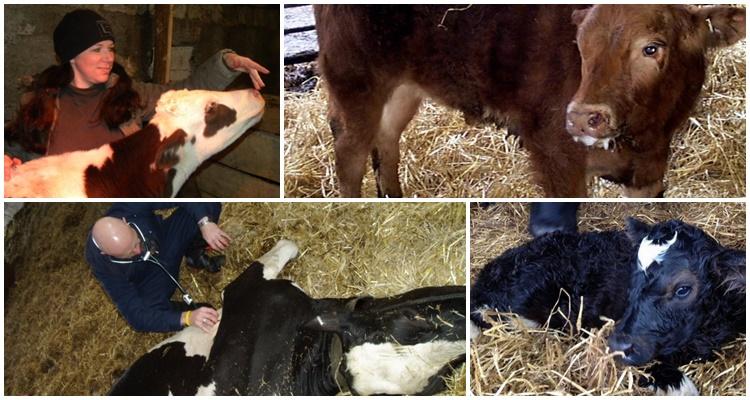
Young animals under the age of 1.5 years are more often exposed to the acute development of the disease. Pregnancy of animals often ends in abortion. In a cow, milk separation is reduced, if not completely stopped. It takes on a saffron hue. The coat becomes dull, disheveled. Necrotic formations appear on the mucous membrane of the oral cavity and skin in the back, tail of the neck. As a result, the body of the pet becomes covered with ulcers. The disease lasts no more than 10 days. In the absence of medical care, in 50% of cases, the animal runs the risk of dying from asphyxia.
The chronic form of the disease is accompanied by significant weight loss, jumps in body temperature, an increase in inguinal lymph nodes, the appearance of blood in the urine of the animal. The pet is tormented by frequent urge to urinate and rapid breathing. Animals hide from bright light and shed heavily. As a result, the pet's skin is covered with bald spots. Sick cows have problems with the reproductive system. Pregnancy of pets often ends in abortion or the birth of sick offspring. Postpartum complications are common.
The atypical form of leptospirosis begins with a short-term, slight increase in temperature (by 0.5-1 degrees). The animal becomes a little lethargic. The mucous membranes of the pet acquire a yellowish tint. Hemoglobin (hemoglobinuria) appears in the urine. This condition lasts from 12 to 96 hours, then the pets recover completely.
How to make a diagnosis
First of all, the veterinarian examines the animal to see the clinical picture of the sick pet's condition. The specialist takes into account not only the external signs of pet discomfort, but also his behavior. At the next stage, blood, urine and samples of other physiological secretions are taken from the animal for analysis. The samples obtained are examined to detect antibodies to parasites - leptospira.Specialists do bacteriological culture on suitable selective media, as well as conduct a general hematological examination.
An indicator of the disease is a significant decrease in the number of erythrocytes in the pet's blood, a sharp drop in sugar levels, changes in hemoglobin indicators.
Additional studies are performed by PCR. As part of the samples, DNA and RNA contained in leptospira are detected. If there is a case of death of a pet in the herd, the veterinarian prescribes a postmortem examination. Confirmation of the disease are:
- Yellow tint to the skin and mucous membranes.
- Necrosis and edema.
- Bloody accumulations in the chest and abdomen.
- Enlargement of the liver.
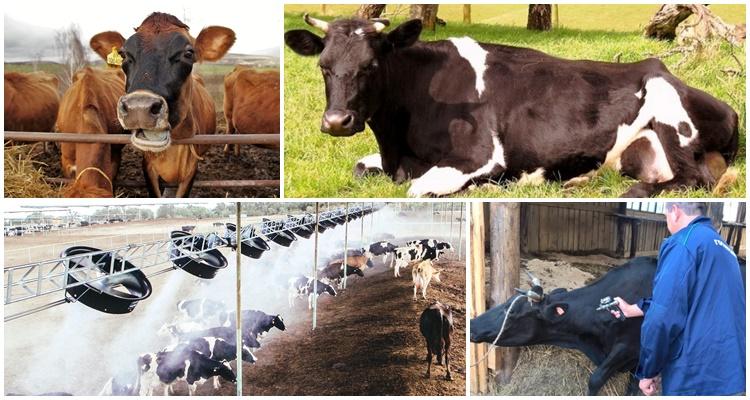
How to properly treat a disease
Treatment includes 2 courses: antimicrobial therapy and elimination of disease symptoms. First of all, sick pets are separated from the herd. Infected animals are injected with antileptospirosis serum. The agent is administered subcutaneously, after 2 days the procedure is repeated. A dose of 20-60 ml is enough for calves, 50-120 ml of serum is administered to adult pets.
Antimicrobial therapy
For the destruction of infectious agents use drugs "Streptomycin" (subcutaneous injection of 10-12 units per kg of pet weight), "Kanamycin" (intramuscularly 15 units per kg of animal weight). The means "Tetracycline" and "Biomycin" effectively cope with the task. They are given to animals 2 times a day for 4 days.
Symptomatic treatment
Simultaneously with antimicrobial therapy, the animal is injected with "Urotropin", 40% glucose solution and caffeine. The consequences of intestinal atony are eliminated with the help of Glauber's salt. The pet's oral cavity is regularly treated with a solution of potassium permanganate. The diet of the animal is enhanced with vitamin supplements and microelements. Supplements in the form of fishmeal or fish oil will benefit your pet.
Prevention and vaccines
For the prevention of an infectious disease, a modern vaccine VGNKI is used. The multivalent agent protects pets from the acute form of leptospirosis. For a lasting effect, it is necessary to regularly revaccinate. One-year-old calves are vaccinated once every six months, adult animals - once a year.
The rest of the preventive measures consist in the monthly treatment of the places where animals are kept with antibacterial agents and the preventive examination of the pets. Cattle are not recommended to graze in waterlogged meadows and nearby areas.

